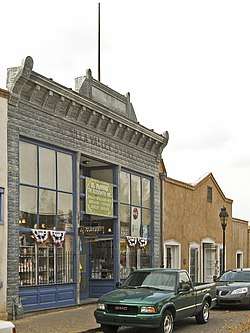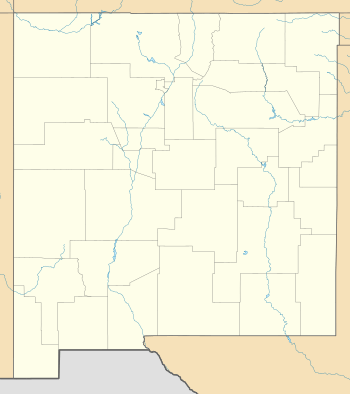Barela-Reynolds House
The Barela-Reynolds House is a historic adobe and brick building complex on the historic plaza in Mesilla, New Mexico, with a store at the front and a house at the rear. A zaguan (covered entryway) leads to a rear courtyard about 30 by 30 feet (9.1 m × 9.1 m) in plan, enclosed by the buildings, the oldest of which were built around 1850. Two separate parts were merged into one property in 1903. North of the zaguan was a store operated during the 1850s by trader Mariano Yrissari and later by trader Mariano Barela. The front of this portion is topped by a triangular parapet, a Greek Revival style feature adopted into New Mexico's Territorial style, and the triangle is repeated in pedimented lintels of two doorways and two large windows. This part was a silversmith shop, "El Platero", in 1977 (per National Register nomination), which moved to the other part by 2009 (per photo). South of the zaguan is a portion occupied by an antique shop, "Las Viejas" , in 1977 (and occupied by "El Platero" in 2009). This part has a cast iron front and a metal, bracketed cornice, with a flagpole centered above. It was the "notions and dry goods department" of the Reynolds and Griggs Co., a firm which operated feed and grocery business in the next building to the south, not part of this property.[2]
Barela-Reynolds House | |
 Front facade of the two-part property in 2009. Reynolds house portion to the left (south); Barela house portion is to the right (north). The central zaguan is through the first doorway in the Barela house facade. | |
 | |
| Location | Off NM 292, Mesilla, New Mexico |
|---|---|
| Coordinates | 32°16′27″N 106°47′43″W |
| Area | 0.5 acres (0.20 ha) |
| Built | c.1850 |
| Architectural style | Territorial |
| NRHP reference No. | 78001815[1] |
| Added to NRHP | January 20, 1978 |
Part of the complex was built around 1850, the year that the New Mexico Territory was established, for Anastacio Barela and his wife, Maria Rafaela Garcia Barela.[2] It was purchased and remodelled by William Charles Reynolds in 1903–04.[2] From 1913 to 1937, it belonged to Fr. Juan Grange of San Albino Church, who taught catechism here.[2] Part of the present property was purchased and refurbished by J. Paul Taylor in 1953.[2] The building has been listed on the National Register of Historic Places since January 20, 1978.[1]
References
- "National Register Information System". National Register of Historic Places. National Park Service. November 2, 2013.
- John Baxter (July 8, 1977). "National Register of Historic Places Inventory/Nomination: Barela-Reynolds House". National Park Service. Retrieved February 8, 2019. With accompanying eight photos from 1974